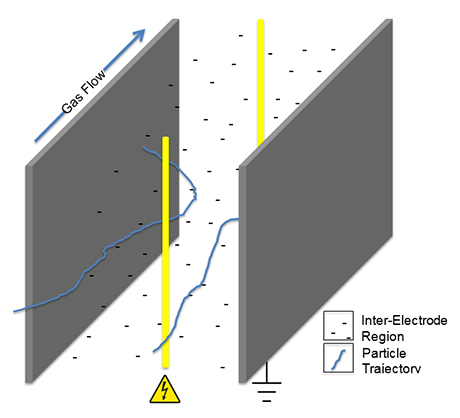Introduction to ESPs: Theory of Operations: Charging
Charging
A typical ESP has thin wires called discharge electrodes (DE), which are evenly spaced between large plates called collection electrodes (CE). Think of an electrode as something that can conduct or transmit electricity. In the case of an ESP, a negative, high-voltage, pulsating, direct current is applied to the DEs in order to create a negative electric field and induce ionization of the passing PM. For the sake of understanding the charging process, the negative electric field can be mentally divided into three regions. The first region is right next to the discharge electrode, where the field is the strongest. The second region includes space between the DE and CE called the inter-electrode region, and is weaker than the first. The third region is located near the collection electrode and has the weakest field strength of all.
Corona Discharge: Free Electron Generation
The first region is where the particle charging process begins, and in this small area immediately surrounding the discharge electrode several things happen very rapidly (in a matter of a millisecond). As voltage applied to the DE is increased, it eventually reaches a point when the electric field around the conductor is high enough to form a conductive region, but not high enough to cause electrical breakdown or arcing to nearby objects. This phenomenon is commonly referred to as corona discharge and can be seen by the human eye as a luminous blue glow surrounding the DE. As free electrons created by the corona discharge are repulsed by the negative electric field, they move faster and faster away from the DE. This acceleration causes the electrons to literally crash into passing gas molecules and occasionally knock off some of their electrons. As these gas molecules lose electrons that are negatively charged, they become positively charged ions. So, this is the first thing that happens “ gas molecules are ionized, and electrons are liberated. All this activity occurs very close to the discharge electrode, and as the process continues, it creates more and more free electrons and positive ions. The name for all of this electron generation is avalanche multiplication.
Ionization of Gas Molecules
As electrons leave the strong electrical field region surrounding the discharge electrode, they enter the inter-electrode region where they begin to lose energy and slow down. Though there are still gas molecules in the inter-electrode region, the electrons kind of bump up to them and get captured instead of violently colliding with them, creating negative gas ions. Now we have ionization of gas molecules happening near the discharge electrode as well as in the inter-electrode area, but with a big difference. The ions created near the discharge electrode are positive and remain in that area. However, because the ions created in the inter-electrode area are negative, they want to move with the electrons in the direction opposite the strong negative field.
Charging & Migration
Before PM can be captured, it must first acquire a negative charge and the negative gas ions created in the inter-electrode region play a crucial role in this process. When PM and negative gas ions cross paths, the gas ions stick to the particles and impart a negative charge to them. At first the charge is fairly insignificant, as most particles are huge compared to a gas molecule, but many gas ions can fit on a single particle, and they do. Small particles (less than 1 μm diameter) can absorb œtens of ions, while large particles (greater than 10 μm) can absorb œtens of thousands of ions. Eventually, there are so many ions sticking to the particles, that the particles begin to emit their own negative electric field. When this happens, the negative fields surrounding the saturated particles start to repulse negative gas ions and no additional ions are acquired. This is called the saturation charge and is responsible for inducing the PMs inescapable pull of electrostatic attraction, or migration. Bigger particles have a higher saturation charge and are consequently pulled more strongly to the collection plate than smaller particles that have a smaller saturation charge. Regardless of size, the particles eventually encounter the CE and stick due to adhesive and cohesive forces.
Helpful Resources
KnowledgeBase: Theory of Operation: Collecting
KnowledgeBase: Theory of Operation: Removal
KnowledgeBase: Optimize Corona Power
KnowledgeBase: Major Components Overview
KnowledgeBase: Discharge Electrodes



